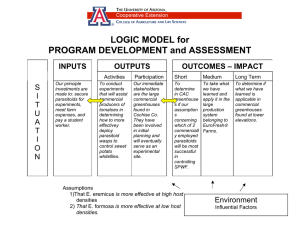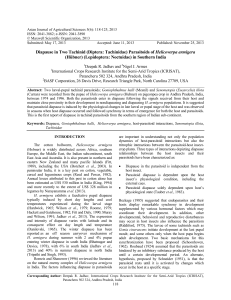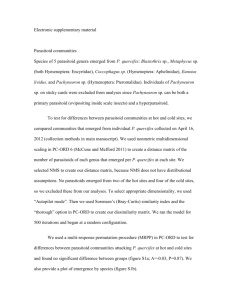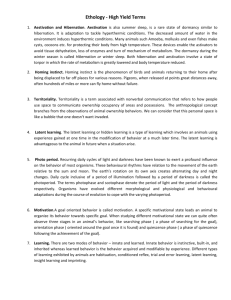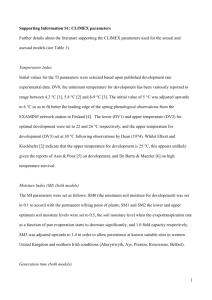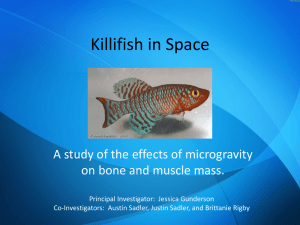Asian Journal of Agricultural Sciences 5(6): 118-125, 2013
advertisement
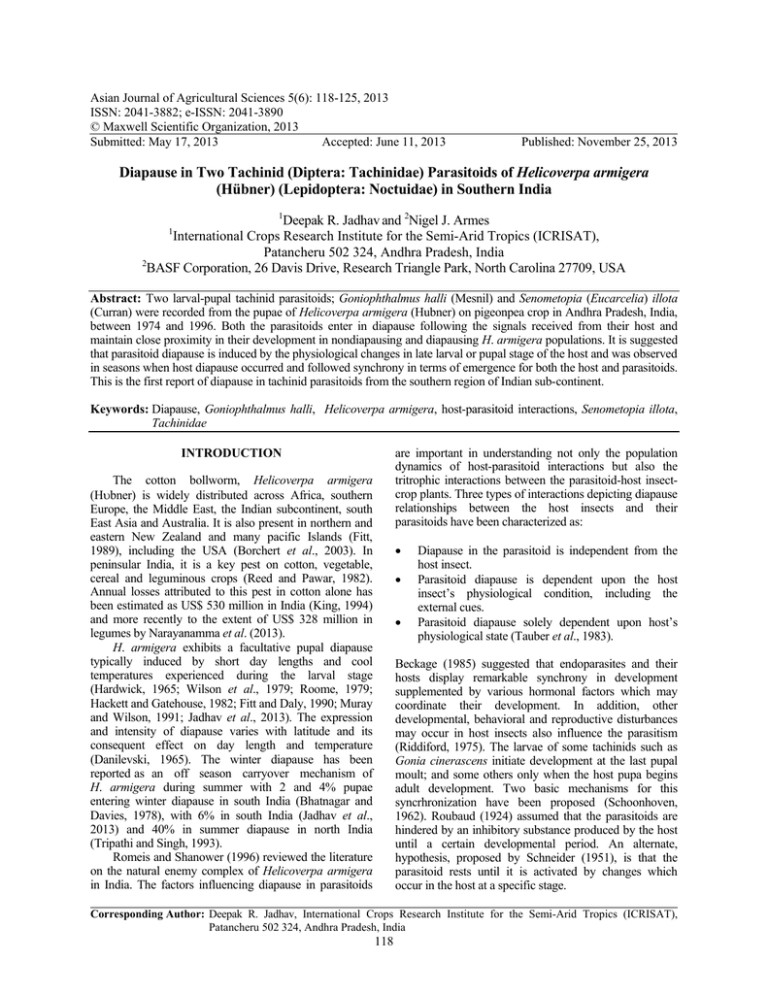
Asian Journal of Agricultural Sciences 5(6): 118-125, 2013 ISSN: 2041-3882; e-ISSN: 2041-3890 © Maxwell Scientific Organization, 2013 Submitted: May 17, 2013 Accepted: June 11, 2013 Published: November 25, 2013 Diapause in Two Tachinid (Diptera: Tachinidae) Parasitoids of Helicoverpa armigera (Hübner) (Lepidoptera: Noctuidae) in Southern India 1 Deepak R. Jadhav and 2Nigel J. Armes International Crops Research Institute for the Semi-Arid Tropics (ICRISAT), Patancheru 502 324, Andhra Pradesh, India 2 BASF Corporation, 26 Davis Drive, Research Triangle Park, North Carolina 27709, USA 1 Abstract: Two larval-pupal tachinid parasitoids; Goniophthalmus halli (Mesnil) and Senometopia (Eucarcelia) illota (Curran) were recorded from the pupae of Helicoverpa armigera (Hubner) on pigeonpea crop in Andhra Pradesh, India, between 1974 and 1996. Both the parasitoids enter in diapause following the signals received from their host and maintain close proximity in their development in nondiapausing and diapausing H. armigera populations. It is suggested that parasitoid diapause is induced by the physiological changes in late larval or pupal stage of the host and was observed in seasons when host diapause occurred and followed synchrony in terms of emergence for both the host and parasitoids. This is the first report of diapause in tachinid parasitoids from the southern region of Indian sub-continent. Keywords: Diapause, Goniophthalmus halli, Helicoverpa armigera, host-parasitoid interactions, Senometopia illota, Tachinidae INTRODUCTION are important in understanding not only the population dynamics of host-parasitoid interactions but also the tritrophic interactions between the parasitoid-host insectcrop plants. Three types of interactions depicting diapause relationships between the host insects and their parasitoids have been characterized as: The cotton bollworm, Helicoverpa armigera (Hυbner) is widely distributed across Africa, southern Europe, the Middle East, the Indian subcontinent, south East Asia and Australia. It is also present in northern and eastern New Zealand and many pacific Islands (Fitt, 1989), including the USA (Borchert et al., 2003). In peninsular India, it is a key pest on cotton, vegetable, cereal and leguminous crops (Reed and Pawar, 1982). Annual losses attributed to this pest in cotton alone has been estimated as US$ 530 million in India (King, 1994) and more recently to the extent of US$ 328 million in legumes by Narayanamma et al. (2013). H. armigera exhibits a facultative pupal diapause typically induced by short day lengths and cool temperatures experienced during the larval stage (Hardwick, 1965; Wilson et al., 1979; Roome, 1979; Hackett and Gatehouse, 1982; Fitt and Daly, 1990; Muray and Wilson, 1991; Jadhav et al., 2013). The expression and intensity of diapause varies with latitude and its consequent effect on day length and temperature (Danilevski, 1965). The winter diapause has been reported as an off season carryover mechanism of H. armigera during summer with 2 and 4% pupae entering winter diapause in south India (Bhatnagar and Davies, 1978), with 6% in south India (Jadhav et al., 2013) and 40% in summer diapause in north India (Tripathi and Singh, 1993). Romeis and Shanower (1996) reviewed the literature on the natural enemy complex of Helicoverpa armigera in India. The factors influencing diapause in parasitoids • • • Diapause in the parasitoid is independent from the host insect. Parasitoid diapause is dependent upon the host insect’s physiological condition, including the external cues. Parasitoid diapause solely dependent upon host’s physiological state (Tauber et al., 1983). Beckage (1985) suggested that endoparasites and their hosts display remarkable synchrony in development supplemented by various hormonal factors which may coordinate their development. In addition, other developmental, behavioral and reproductive disturbances may occur in host insects also influence the parasitism (Riddiford, 1975). The larvae of some tachinids such as Gonia cinerascens initiate development at the last pupal moult; and some others only when the host pupa begins adult development. Two basic mechanisms for this syncrhronization have been proposed (Schoonhoven, 1962). Roubaud (1924) assumed that the parasitoids are hindered by an inhibitory substance produced by the host until a certain developmental period. An alternate, hypothesis, proposed by Schneider (1951), is that the parasitoid rests until it is activated by changes which occur in the host at a specific stage. Corresponding Author: Deepak R. Jadhav, International Crops Research Institute for the Semi-Arid Tropics (ICRISAT), Patancheru 502 324, Andhra Pradesh, India 118 Asian J. Agric. Sci., 5(6): 118-125, 2013 Greater understanding is still required on the hostparasitoid developmental synchrony, diapause maintenance and termination, before unraveling the mechanism (s) where the parasitoids synchronize their diapause with their host insect. Tachinid fly Pseudoperichaeta nigrolineata and its host, Ostrinia nubilalis has shown that good synchronization existed between the development of the host and its parasitoid. (Baker et al., 1949) and (Ramadhane et al., 1988) working with Ostrinia nubilalis Hubner (Lepidoptera: Pyralidae) and its tachinid parasitoid Pseudoperichaeta nigrolineata Walker (Diptera: Tachinidae) showed that the tachinid parasitoid larva resumes its growth only at the hosts diapsuse termination, which was due to the low ecdysterone and they also recorded, faster development of the parasitoid larva in non-diapsusing host (Ramadhane et al., 1987). Similarly, the development of P. insidiosa (Diptera: Tachinidae) was studied in the laboratory on the alternative host, Galleria mellonela L. (Lepidoptera: Pyralidae) by Grenier and Delobel (1982) and similar studies on the same hosts, where arrested development was observed Fig. 1: Sampling of H. armigera larval populations conducted in pigeonpea in various districts of Andhra Pradesh, southern India (• Marked denote the districts surveyed) after Jadhav et al., (2013) 119 Asian J. Agric. Sci., 5(6): 118-125, 2013 in the IInd instar of the parasitoid, which was related to the physiological features of the host, especially the ecdysteroid levels (Plantevin et al., 1986). Similarly, the pupae of saturniid Agapema moths gives off brief periods of carbon dioxide attracting host-parasite during development (Buck and Keister, 1956). In the United States based on field studies it was suggested that Braconid parasitoid Microplitis croceipes (Hymenoptera: Braconidae) cocoons overwinter in the soybean fields and adults emerge following summer to coincide with the presence of Helicoverpa zea (Boddie) larvae in the soybean crop for parasitization (Bryan et al., 1969; Zehnder et al., 1990; Herbert et al., 1993). Similarly, Perilitus coccinellae (Shrank) overwinters as a 1st instar within the adult beetle Coleomegilla maculata (DeGeer), a native coccinellid, as an adult in aggregated populations. Their studies examined hibernating populations of both host and parasite from corn fields near New York to determine factors controlling dormancy in the species and the role of dormancy in their seasonal synchrony (Hodek, 1973; Solbreck, 1974) and (Obrycki and Tauber, 1979). During our studies sampling natural populations of Helicoverpa spp. were taken regularly in various field crops to determine the species composition and seasonal dynamics of the parasitoids of H. armigera, over a region of approximately 70,000 km² (latitude: 14.5°-18°N), in Andhra Pradesh State, India during 1974-85 and 1990-96. Data was collected on the duration of pupae of H. armigera and its parasitoids. Present investigation focuses the host-parasitoid interactions in relation to the occurrence of diapause. Last instar larvae going into pupation were collected between mid-November and early December by excavating the top 10 cm soil from the experimental fields of pigeonpea which had severe infestations of H. armigera. The pupae were individually transferred to glass tubes (80×20 mm) and kept in plastic boxes by burying them in the soil at a depth of 15 cm so as to expose them to near ambient temperature conditions. Emergence of both the host insect and the parasitoid was monitored 2-3 times in a week. Statistical analysis: The data was analyzed by Analysis of Variance (ANOVA) using SPSS (Version 15.1). The significance among the data was separated by Tukey’s test at (p≤0.05). RESULTS AND DISCUSSION The incidence of parasitoid was highly variable depending upon the time of host larval availability in the season, the geographic location (Fig. 1) and the cropping patterns (Pawar et al., 1986). Both the tachinid flies [Goniophthalmus halli (Mesnil) and Senometopia (Eucarcelia) illota (Curran)] emerged from the pupae. Parasitism by G. halli was found in the 5th-6th instar larvae of H. armigera and classified as a larval-pupal parasitoid. In general, the mature parasitoid larva emerged from the pupal stage of H. armigera and pupated immediately. Only a single parasitoid larva has been observed to develop from each host pupa. Bhatnagar et al. (1983) reported that S. illota as also a larval-pupal parasitoid. The adult flies oviposited in the 4th -6th instar larvae of H. armigera and a solitary parasitoid larva emerged from the pupal stage (96% of occasions), or less frequently from the 6th instar larva or pre-pupa (4% of occasions) of the host and pupated immediately. A positive correlation was observed between the total and diapause population of pupae of H. armigera and parasitism by G. halli (r = 0.47*) and S. illota (r = 0.88**). This suggests that increased population of H. armigera resulted in higher parasitism. Further, cyclonic weather conditions promoted induction of diapause H. armigera pupae and the parasitoids. However, the intensity of parasitism in the larvae is highly correlated by S. illota compared to G. halli. From the larval population of H. armigera collected at the ICRISAT farm, the occurrence of pupal diapause ranged 0-16.80% during November-January (Table 1) and was highly variable between the seasons. On the other hand, the diapause was never found among the larval collections made in May-October. However, one out of 13 seasons, a small percentage of pupae (2.78%) resulting from the larval collections made during MarchApril underwent diapause at the pupal stage (Jadhav et al., 2013). Diapause in H. armigera was greater 16.80 and 15.10% in 1995-96 and 1977-78 (Table 1), coinciding with cyclonic weather conditions prevailed for MATERIALS AND METHODS Larvae of Helicoverpa armigera were sampled from different crop fields in seven districts of Andhra Pradesh viz., Adilabad, Anantapur, Karimnagar, Kurnool, Mahbubnagar, Medak, Warangal and Hyderabad (Fig. 1). Pigeonpea (Cajanus cajan (L.) Millsp.) plants were sampled during Nov-Dec each year. Different larval instars collected were categorized into early (1st-3rd) and late (4th-6th) and reared individually in 80×20 mm glass tubes, by supplementing with tender pigeonpea pods as food which were changed on alternate days till pupation and placing them in a shade in the screen-house at ICRISAT farm. In this way, the larvae were exposed to ambient temperature and photoperiod conditions. On pupation, they were transferred to 30-mL containers filled with sandy loam soil and marked for the date of pupation. Both the emergence of the host insect or the parasitoid was recorded. Parasitism was suspected as the cause of death, wherein no parasite emerged and the host pupae were dissected to determine the presence of the parasite and its identity. 120 Asian J. Agric. Sci., 5(6): 118-125, 2013 Table 1: Seasonal incidence of diapause and tachinid parasitism in H. armigera pupae based on field collections of the larval stage on pigeonpea between November and December in Andhra Pradesh, southern India (1974-1996) Tachinid field parasitism (%) -----------------------------------------------Year H. armigera pupae sampled (no.) Diapause pupae (%) G. halli S. illota 1974-75 335±2.50ef 1.50c 19.11a 12.50b 1975-76 934±2.40d 2.00c 10.21bc 13.21b 1976-77 1330±1.50c 0.20d 4.90d 8.93c a a b 1977-78* 3500±5.50 15.11 12.90 20.85a 1978-79 218±2.10f 1.83c 6.00c 4.56d 1980-81 435±2.00e 0.00 0.91e 2.07e 1981-82 150±3.00g 9.35b 0.72e 1.38e 1982-83 200±0.90f 0.00 6.00c 4.05d 1984-85 284±1.20f 1.41c 3.50d 5.25d 1990-91 100±0.70g 3.01c 7.00c 4.09d f d 1991-92 205±0.60 0.00 2.00 2.47e 1992-93 274±2.50ef 0.00 3.21d 5.80d 1995-96* 2729±5.50b 16.80a 11.71b 17.46a Values (Mean+SEM) carrying the same alphabet (s) within a column are not significantly different by Tukey’s test, (p<0.05); *1977-78 & *1995-96: cyclonic years Table 2: Number of days to emergence in non-diapausing and diapausing H. armigera pupae and its primary parasitoids G. halli and S. illota collected from pigeonpea crop in Andhra Pradesh, southern India (1974-1996) Non-diapause development duration to emergence (days) Diapause development duration to emergence (days) Year/ ----------------------------------------------------------------------------- ------------------------------------------------------------------------------species No. Mean Range % of population No. Mean Range % of population 1977-78* H. armigera 2971a 15.9±0.06a 13-24 84.90 529a 67.5±0.06b 40-132 15.10 G. halli 453c 25.7±0.06b 17-29 95.40 22b 79.4±1.95a 79-103 4.60 b b b a S. illota 728 24.0±0.05 12-29 97.60 18 76.2±2.98 60-113 2.40 1995-96* H. armigera 2268a 18.0±0.02a 13-29 83.10 461a 69.0±1.04b 35-169 16.90 G. halli 318c 18.7±0.08a 15-29 94.40 19c 76.3±4.34a 45-139 5.60 b a b b S. illota 474 18.2±0.05 12-26 95.00 25 61.7±4.17 30-145 5.00 Values carrying same letter (s) are not statistically significant as per Tukey’s test (p<0.05); *: Cyclonic year 7-9 days in October-mid-November over large areas of Andhra Pradesh as well as the neighboring states (Pedgley et al., 1987). This resulted in overcast skies and frequent rains followed by cooler temperatures. Such weather events during critical windows of vulnerability are not reported in monthly weather charts (Martinat, 1987), but can have severe effects on development of H. armigera. During 1981-82, a high frequency of diapause (9.30%) was observed in December (Table 1). In the present studies, the duration of pupal period in H. armigera ranged from 40-132 and 35-169 days in 1977-78 and 1995-96, respectively (Table 2). Diapause was found in the larval-pupal parasitoids, G. halli and S. illota, during November-January in 197778 and 1995-96, when the incidence of host diapause was high (Table 2). They pupated at the normal time in both the species, killing the host pupa. During the 1977-78 seasons, the duration from host pupation to parasitoid emergence in the non-diapausing parasitoid population averaged 25.70 and 24.00 days for G. halli and S. illota, respectively compared to 15.90 days for the normal host pupal period. The proportion of parasitoids undergoing diapause development was small with 4.60 and 2.40% in 1977-78 but was greater at 5.60% for G. halli and 5.00% for S. illota in 1995-96. The diapause by the parasitoids extended the development period to 45-139 and 30-145 days in G. halli and S. illota, respectively (Table 2). From the data it appears that G. halli and S. illota are able to maintain close developmental synchrony with non-diapausing and diapausing H. armigera populations. In non-diapausing hosts, the parasitoids took 8-10 days for emergence. Such a delay would ensure that mid-late instar larvae are available in the pigeonpea crop for parasitoids soon after their emergence (Fig. 2). In 199596, the average periods for the host and parasitoids were similar. While the range of pupal periods for H. armigera and G. halli were significantly larger during 1977-78, which enabled maintenance of both the synchrony for emergence and parasitism. Similarly, with diapause development in 1977-78 and 1995-96, the emergence of the host and parasitoids occurred during similar periods (February-May, 1978; January-May, 1996), despite the intra population variation in the timing of diapause emergence was large for both the host as well as the parasitoids (Table 2). Diapause development in the host pupae and emergence of H. armigera diapaused moths along with its two diapaused parasitoids G. halli and S. illota and its synchronized emergence with the S. illota nos. being slightly higher than that of G. halli, with weeks 5 to 12 there was a continuous emergence of both the parasitoids (Fig. 3). Reed (1965) reported diapause in G. halli parasitizing H. armigera in Tanzania and suggested that it was the parasitoid egg or young larva that underwent diapause inside the host pupa, resuming its development after the termination of host diapause. This contrasts with 121 Asian J. Agric. Sci., 5(6): 118-125, 2013 Weekly larval (nos.) 400 350 300 250 200 150 100 50 1 2 3 4 Jan 5 6 7 8 9 10 11 12 13 14 15 16 17 18 19 20 21 22 23 24 Feb Standard weeks Mar Apr May Fig. 2: H. armigera larval availability on pigeonpea crop in Andhra Pradesh, southern India between 1974-1996 Fig. 3: H. armigera diapaused moth emergence along with its diapaused parasitoids with synchronized emergence of G. halli and S. illota in pigeonpea in Andhra Pradesh, southern India between 1974-1996 the present data, where it is always the parasitoid pupal stage that underwent diapause after killing the host. The induction of winter diapause in the pupae of H. armigera typically occurs by exposure of larvae to short photoperiod (<12 L) and low temperatures (1923°C) (Wilson et al., 1979; Hackett and Gatehouse, 1982; De Souza et al., 1995). As far as the day length is concerned, Hyderabad region (latitude: 17°30N) is on the border-line for the induction of diapause, with photoperiods of slightly <12 h during winter in October-January. Further, the temperature usually fall within the diapause induction range for the winter period with minimum night temperatures as low as 5°C in some weeks in most of the years. Over a 13-year study period, significant frequencies of diapause in both host and parasitoids occurred predominantly in the two seasons coinciding with prolonged periods of cyclonic weather conditions prevailed in November. This suggests that reduced photoperiods as a result of lower light intensity consequent to dull overcast day and reduced environmental temperatures, were possibly the stimuli triggering the increased proportion of larvae to undergo diapause. Therefore, it is likely that the larval-pupal parasitoid diapause induced by the physiological changes either in the late larval or pupal stage of the host. Indirect evidence comes from the fact that the diapause in the parasitoids was observed in seasons when there was a synchrony in emergence of both the host and parasitoid (Fig. 3). Hormonal studies on Heliothis virescens (Fab.) have shown that the signal to induce diapause (reduced ecdysteroid titre) comes shortly after entering into diapause with increased ecdysteroid titres (Loeb, 1982). In Heliothis zea (Boddie) it was demonstrated that the prothoracic glands are the source of ∝-ecdysone and the diapause is maintained by an ecdysone deficiency, which itself is mediated by temperature (Meola and Adkisson, 122 Asian J. Agric. Sci., 5(6): 118-125, 2013 1977). Similarly, in the wax moth, Galleria mellonella L., the development of tachinid parasitoid, Gonia cinerascens Rond. is triggered by the release of the host’s ecdysteroids (Baronio and Sehnal, 1980). Schoonhoven (1962) has demonstrated that larval diapause in Eucarcelia rutilla Vi11., an endo-parasite of the pinelooper Geometridae Bupalus piniarius L., is regulated by the prothoracic gland hormone of the host. The hormone stimulates the parasite to synchronize its life cycle with that of the host. The mechanism of hormonal control of diapause in H. armigera is unknown, but it is believed to be analogous to other Heliothis/Helicoverpa species. In view of close synchrony in the emergence pattern from non-diapause and diapause populations of H. armigera and the tachinid parasitoids (Table 2), it is speculated the parasitoids, G. halli and S. illota may obtain cues for diapause based on the available ecdysone titres at host pupation. The fact the parasitoids kill the host soon after host pupation may suggest that the reduced ecdysone levels at host pupation are sufficient to ‘prime’ the parasitoids entering diapause and programmed development for the break in diapause following emergence in reasonable synchrony with the nonparasitized diapausing hosts. Although mechanism is speculative, conclusive evidence can only be obtained through a thorough investigation of hormonal and nutritional interaction between the host and its parasitoids. Alternatively, it is possible that the parasitoids may be responding to the abiotic factors such as temperature and photo-period in much the same manner as the host. From the biological control point of view, both G. halli and S. illota may influence the buildup of H. armigera populations and prove potential by preventing the succeeding generations of the host insect from causing significant damage. Murray and Zalucki (1994) opined that moderate levels of pupal parasitism may significantly affect the host dynamics and this particularly true in diapausing pupal populations of H. armigera (Fitt and Daly, 1990). As winter diapause in H. armigera is likely to increase at higher latitudes, the synchronous association of the parasitoids with the host may play a significant role in affecting the population buildup of H. armigera. greater no. of pods are damaged by the grown up larvae causing significant yield losses. ACKNOWLEDGMENT From 1974-1986 data was collected under the guidance of Dr. V. S. Bhatnagar, former Cropping Systems Entomologist with ICRISAT. Between 19881996 funding was provided by DfID, UK for collection of data. Dr. N. P. Wyatt (Diptera) of the identification service CABI International Institute of Entomology, UK provided authoritative identification of the parasitoids. REFERENCES Baker, W.A., W.G. Bradley and C.A. Clark, 1949. Biological control of the European corn borer in the United States. Bull. United States Depart. Agril., 983: 1-185. Baronio, P. and F. Sehnal, 1980. Dependence of the parasitoid Gonia cinerascens on the hormones of its lepidopterous hosts. J. Insect Phys., 26: 619-626. Beckage, N.E., 1985. Endocrine interactions between endoparasitic insects and their hosts. Ann. Rev. Entomol., 30: 371-413. Bhatnagar, V.S. and J.C. Davies, 1978. Factors affecting populations of gram podborer, Heliothis armigera (Hubner) (Lepidoptera: Noctuidae) in the period 1974-77 at Patancheru (Andhra Pradesh). Bull. Entomol., 19: 52-64. Bhatnagar, V.S., S. Sithanantham, C.S. Pawar, D.R. Jadhav, V.R. Rao and W. Reed, 1983. Conservation and augmentation of natural enemies with reference to integrated pest management in chickpea (Cicer arietinum L.) and pigeonpea (Cajanus cajan (L.) Millsp.). Proceedings of the International Workshop on Integr. Pest Manag. in Grain Legumes, EMBRAPA, Goiania, Brazil, April, 4-9, pp: 157-180. Borchert, D.M., R.D. Magarey and G.A. Fowler, 2003. Pest assessment: Old World Bollworm, Helicoverpa armigera (Hubner) (Lepidoptera: Noctuidae). USDA-APHIS- PPQ-CPHST- PERAL/NCSU. NAPPFAST, pp: 9. Retrieved from: http:// www. nappfast.org/ pest%20reports/armigera.pdf. Bryan, D.E., C.G. Jackson and R. Patana, 1969. Laboratory studies of Microplitis croceipes, a braconid parasite of Heliothis spp. J. Econ. Entomol., 62: 1141-1144. Buck, J. and M. Keister, 1956. Host-parasite relations in Agapema pupae (Lepidoptera: Saturniidae). Ann. Entomol. Soc. Ameri., 49: 94-97. Danilevski, A.S., 1965. Photoperiodism and Seasonal Development of Insects. Oliver and Boyd, Edinburgh. CONCLUSION The cyclonic weather conditions have an important effect on the diapasue of H. armigera pupae and the parasitoids. The parasitoid pupal stage underwent diapause after killing the host insect pest. Both the tachinid parasitoids cause significant parasitism in late instar grown up larvae of Heliothis, causing greater reduction in the larval population build-up in the fields of pigeonpea. However, they are not the candidates for biological control of H. armigera larvae, as they parasitize the developed 4th-6th instar larvae by that time 123 Asian J. Agric. Sci., 5(6): 118-125, 2013 De Souza, K., J. Holt and J. Colvin, 1995. Diapause, migration and pyrethroid-resistance dynamics in the cotton bollworm, Helicoverpa armigera (Lepidoptera: Noctuidae). Ecol. Entomol., 20: 333-342. Fitt, G.P., 1989. The ecology of Heliothis species in relation to agroecosystems. Ann. Rev. Entomol., 34: 17-52. Fitt, G.P. and J.C. Daly, 1990. Abundance of overwintering pupae and the spring generation of Helicoverpa spp. (Lepidoptera: Noctuidae) in New South Wales. Austr. J. Econ. Entomol., 83: 1827-1836. Grenier, S. and B. Delobel, 1982. Pseudoperichaeta insidosa, nouveau achinaire (Dipotera) eleve dans Galleria mellonella L. (Lepidoptera). Entomophaga, 27: 141-146. Hackett, D.S. and A.G. Gatehouse, 1982. Diapause in Heliothis armigera (Hubner) and H. fletchri (Hardwick) (Lepioptera : Noctuidae) in the Sudan Gezira. Bull. Entomol. Res., 72: 409-422. Hardwick, D.F., 1965. The corn earworm complex. Memoirs Entomol. Soc. Canada, 40: 247. Herbert, D.A., G.W. Zehnder, J. Speese and T. Moss, 1993. Parasitization and timing of diapause in virginia Microplitis croceipes (Hymenoptera: Braconidae): Implications for biocontrol of Helicoverpa zea (Lepidoptera: Noctuidae) in Soybean. Environ. Entomol., 22(3): 693-698. Hodek, I., 1973. Biology of Coccinellidae. Junk. The Hague. Academia, Prague, pp: 260. Jadhav, D.R., N.J. Armes and V.S. Bhatnagar, 2013. Incidence of winter and summer diapause in Helicoverpa armigera (Lepidoptera: Noctuidae) in Andhra Pradesh, India. Asian J. Agril. Sci., 5(3): 40-51. King, A.B.S., 1994. Heliothis/Helicoverpa (Lepioptera: Noctuidae). In: Matthews, G.A. and J.P. Tunstall (Eds.), Insect Pests of Cotton. CAB International, Oxon, pp: 39-106. Loeb, M.J., 1982. Diapause and development in the tobacco budworm. Heliothis virescens: A comparison of haemolymph ecdysteroid titres. J. Insect Physiol., 8: 667-673. Martinat, P.J., 1987. The Role of Climatic Variation and Weather in Forest Insect Outbreks. In: Barbosa, P. and J.C. Schultz (Eds.), Insect Outbreaks. Academic Press, New York, pp: 241-268. Meola, R.W. and P.L. Adkisson, 1977. Release of prothoracicotropic harmone and potentiation of developmental ability during diapause in the bollworm, Heliothis zea. J. Insect Physiol., 23: 683-688. Muray, D.A.H. and A.G.L. Wilson, 1991. Methods for Studying Diapause. In: Myron, P.Z. (Ed.), Heliothis: Research Methods and Prospects. Chapter 9, Springer-Verlag, NY, pp: 102-108. Murray, D.A.H. and M.P. Zalucki, 1994. Spatial distribution and mortality of Helicoverpa spp. Pupae (Lepioptera: Noctuidae) under field crops on the Darling Downs, Queensland. J. Austr. Entomol. Soc., 33: 193-198. Narayanamma, V.L., C.L.L. Gowda, M. Sriramulu, M.A. Ghaffar and H.C. Sharma, 2013. Nature of gene action and maternal effects for pod borer, Helicoverpa armigera resistance and grain yield in chickpea, Cicer arietinum. Amer. J. Plant Sci., 4: 26-37. Obrycki, J.J. and M.J. Tauber, 1979. Seasonal synchrony of the parasite Perilitus coccinellae and its host Coleomegilla maculata. Environ. Entomol., 8: 400-405. Pawar, C.S., V.S. Bhatnagar and D.R. Jadhav, 1986. Host plants and natural enemies of Heliothis spp., in India: a compendium. Progress Report-13. Resource Management Program, International Crops Research Institute for the Semi-Arid Tropics, Patancheru P.O. Andhra Pradesh 502 324, India, pp: 1-106. Pedgley, D.E., M.R. Tucker and C.S. Pawar, 1987. Windborne migration of Heliothis armigera (Hubner) (Lepioptera: Noctuidae) in India. Insect Sci. Appl., 8: 599-604. Plantevin, G., S. Grenier, G. Richard and C. Nardon, 1986. Larval development arrest and hormonal levels in the couple Galleria mellonella (Lepidoptera: Pyralidae) Pseudoperichaeta nigrolineata (Diptera: Tachinidae). Arc. Insect Biochem. Physiol., 3: 457-469. Ramadhane, A.S., S. Grenier and G. Plantevin, 1987. Physiological interactions and development synchronization between non-diapausing Ostrinia nubilalis larvae and the tachinid parasitoid Pseudoperichaeta nigrolineata. Entomol. Exp. Appl., 45: 157-165. Ramadhane, A.S., S. Grenier and G. Plantevin, 1988. Photoperiod, temperature and ecdysteroid influences on physiological interactions between diapausing Ostrinia nubilalis larvae and the tachinid Pseudoperichaeta nigrolineata. Entomol. Exp. Appl., 48: 275-282. Reed, W., 1965. Heliothis armigera (Hb.) (Noctuidae) in western Tanganyika. II.-Ecology and natural and chemical control. Bull. Entomol. Res., 56: 127-140. Reed, W. and C.S. Pawar, 1982. Heliothis: A global problem. Proceedings of the International Workshop on Heliothis Management. November 15-20, 1981, ICRISAT Center, Patancheru, A.P., India, pp: 9-14. Riddiford, L.M., 1975. Host Hormones and Insect Parasites. In: Maramorosch, K. and R.E. Schope (Eds.), Invertebrate Immunity. Academic Press, New York, pp: 339-353. Romeis, J. and T.G. Shanower, 1996. Arthropod natural enemies of Helicoverpa armigera (Hubner) (Lepioptera: Noctuidae) in India. Biocont. Sci. Tech., 6: 481-508. 124 Asian J. Agric. Sci., 5(6): 118-125, 2013 Tauber, M.J., C.A. Tauber, J.R. Nechols and J.J. Obrycki, 1983. Seasonal Activity of Parasitoids: Control by External, Internal and Genetic Factors. In: Brown, V.K. and I. Hodek (Eds.), Diapause and Life Cycle Strategies in Insects. Junk, The Hague, pp: 87-108. Tripathi, S.R. and R. Singh, 1993. Seasonal bionomics of Heliothis armigera (Hubner) (Lepioptera: Noctuidae) in the Terai belt of Uttar Pradesh. Ins. Sci. Appl., 14: 439-444. Wilson, A.G.L., T. Lewis and R.B. Cunningham, 1979. Overwintering and spring emergence of Heliothis armigera (Hubner) (Lepioptera: Noctuidae) in the Namoi Vally, New South Wales. Bull. Entomol. Res., 69: 97-109. Zehnder, G.W., D.A. Herbert, R.M. McPherson, J. Speese and T. Moss, 1990. Incidence of Heliothis zea (Lepidoptera: Noctuidae) and associated parasitoids in Virginia soybeans. Environ. Entomol., 19: 1135-1140. Roome, R.E., 1979. Pupal diapause on Heliothis armigera (Hubner) (Lepioptera: Noctuidae) in Botswana: its regulation by environmental factors. Bull. Entomol. Res., 69: 149-160. Roubaud, E., 1924. History Anacamptomyies, flies parasitic wasps socialist Africa. Ann. Sci. Nat. Zool., 7: 197-248. Schneider, L.M., 1951. Some physiological Bezichungen between Syrphidae larvaen and their parasites. Z. Ang. Ent., 33: 150-162. Schoonhoven, L.M., 1962. Diapause and the physiology of host-parasite synchronization in Bupalus piniarius L. (Geometridae) and Eucarcelia rutilla Vi11. (Tachinidae). Archs. Neerl. Zool., 15: 111-174. Solbreck, C., 1974. Maturation of post-hibernation flight behaviour in the coccinellid Coleomegilla maculata (DeGeer). Oecologia 17: 265-275. 125
